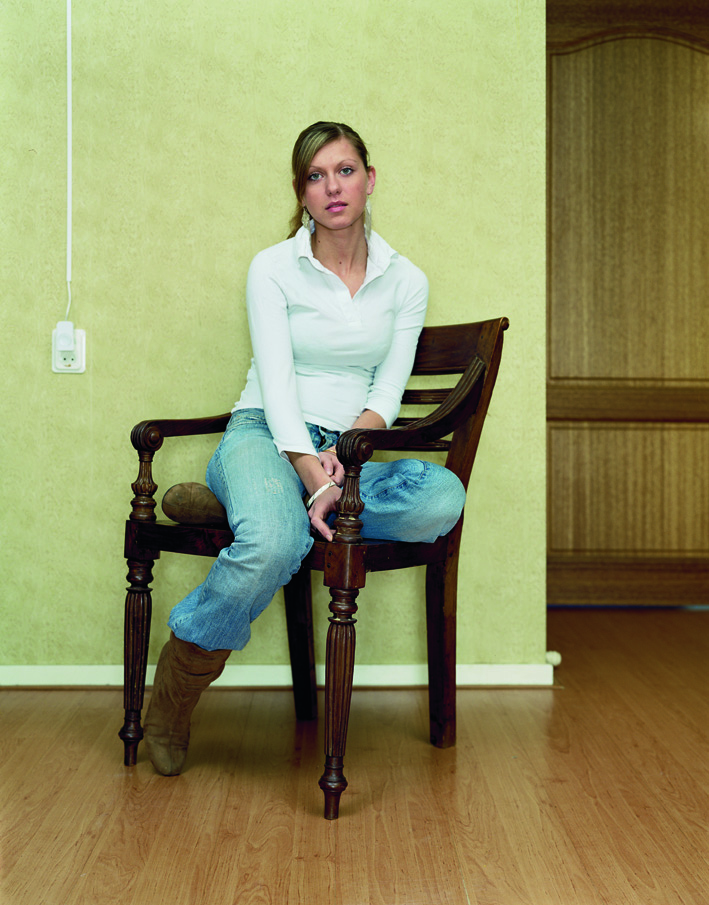
Rineke Dijkstra, Almerisa, Leidschendam, The Netherlands, March 29, 2005, 2005. Chromogenic color print, 24 3/8 x 20 1/2 inches (61.9 x 52.1 cm). Gift of Sandra and Gerald Fineberg. Courtesy the artist and Marian Goodman Gallery. © Rineke Dijkstra
See Almerisa, Asylum Seekers’ Center, Leiden, The Netherlands, March 14, 1994 for series description.
2012.9
See Almerisa, Asylum Seekers’ Center, Leiden, The Netherlands, March 14, 1994 for series description.
2012.8
See Almerisa, Asylum Seekers’ Center, Leiden, The Netherlands, March 14, 1994 for series description.
2012.7
See Almerisa, Asylum Seekers’ Center, Leiden, The Netherlands, March 14, 1994 for series description.
2012.6
See Almerisa, Asylum Seekers’ Center, Leiden, The Netherlands, March 14, 1994 for series description.
2012.5
See Almerisa, Asylum Seekers’ Center, Leiden, The Netherlands, March 14, 1994 for series description.
2012.4
See Almerisa, Asylum Seekers’ Center, Leiden, The Netherlands, March 14, 1994 for series description.
2012.3
Rineke Dijkstra’s work offers a contemporary take on the genre of portraiture. Often photographing in an objective documentary style, Dijkstra captures her subjects in states of transition: boys becoming soldiers, new mothers, or girls growing up. As the artist stated, “I’m interested in young people because they’re not fully developed. You can only guess which direction they will go. They’re open, an open book, really. And I think that interested me because it is also sort of an abstraction. You can look at [young people] and really project your own feelings and thoughts.” A photograph, by its nature, presents a past moment, and Dijkstra’s portraits lie at the threshold of activity, either after or before an event transpires. The setting is typically devoid of extraneous details, highlighting only the evocative nature of a person’s facial and bodily expression.
The subject here, Almerisa, was six when Dijkstra first photographed her in 1994 at a refugee asylum in Leiden, Netherlands. The ongoing portfolio that emerged records Almerisa’s transformation from a young girl from the former Yugoslavia to a woman, now a mother, from Western Europe. Dijkstra’s compositions maintain a spare and consistent format (frontal symmetrrical, seated pose, blank background), accentuating the changes, both physiological and cultural, in Almerisa’s appearance over time. A time-lapse portrait of identity in formation, the photographs also record a broader social context of war-wrought displacement and hybrid belonging. Using a 4 x 5 view camera and an unusually long exposure time, the artist’s technique allows for a quality of detail not often seen in the digital age. Almerisa locks her eyes with the camera lens, as though studying the portraitist and by extension the viewer, summoning a reciprocal gaze.
The ICA/Boston presented the first solo museum exhibition of Dijkstra’s work and has built a strong collection of her photographs. These eleven prints from the Almerisa series join other photographic portraits by such artists as Philip-Lorca diCorcia, Nan Goldin, and Catherine Opie.
2012.2
The work of John Houck explores the possibility of combining multiple perspectives in a single photographic image. Though they appear to be digitally altered, Houck’s photographs develop from a meticulous analog studio-based process of layering successive images to create powerful visual assemblages. Inspired by his training as an architect, Houck constructs small 3-D models or still-life arrangements that he then photographs: “A depiction of space, rather than an actual space,” as the artist has said. Houck frequently turns to objects and materials in his immediate surroundings. In the 2013 series A History of Graph Paper, he created images of items from his childhood that his parents had returned to him. He photographed different iterations of the artifacts by layering, adding, and subtracting materials to create compositions that evoke the complexity of memory in relation to the objects we collect.
Houck’s Petals and Interleaves depicts three books—two open and one closed—staged on a white and gray paper. Houck painted four cubic volumes on the books, which disrupt the perceived space of the photograph. The painted elements point emphatically to the flatness of the picture plane, with the volumes painted on the books appearing as holes, suggesting a playful sense of depth. This work was included in the solo exhibition Playing and Reality—its title taken from a book by British psychoanalyst D. W. Winnicott. Houck’s introduction of painted elements, sometimes as a layered part of the composition, other times directly on the surfaces of his prints, embodies a sense of playfulness modeled on Winnicott’s theories.
This photograph adds further depth to the ICA/Boston’s strong collection of studio-based photography made by contemporary artists such as Anne Collier, Liz Deschenes, Roe Ethridge, Leslie Hewitt, and Sara VanDerBeek.
800.16.13
Fascinated by the relationship between sculpture and photography, Sara VanDerBeek constructs assemblages of objects and images that she then photographs to produce the final work. To locate the materials and images she uses for these fusions of photography and sculpture she searches a variety of sources—art history books, her family photographs, and ephemera she has collected. She shoots numerous rolls of film of each tableau before selecting one.
The sculpture at the center of The Principle of Superimposition 2 is a freestanding screen structure comprised of twenty-four image panels set against a seamless black background. The structure is inspired by a folding screen designed by architect Eileen Gray. The images making up the panels range from photograms found in László Moholy Nagy’s book Vision in Motion (1947) to an Erwin Blumenfield fashion photograph and a picture of women dressed in black burkas and posed on a patterned carpet featured in a Time/Life photography book. For several of the panels, VanDerBeek splices two images together diagonally, “like a filmic cross-fade made concrete,” as the artist has said. In one panel, the geometric patterns of a fifteenth-century Chinese ceramic vessel interpenetrate with a Leni Riefenstahl photograph of a Kau man painting.
This photograph adds depth to the ICA/Boston’s holdings of VanDerBeek’s work, and further strengthens the collection of studio-based photography, which includes works by Roe Ethridge, Pipilotti Rist, Thomas Ruff, and Lorna Simpson.
2017.28